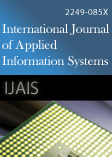
- Anahita Mahzari and Marzieh Ahmadzadeh 2013. Finding Gender Preferences in E-Commerce Website Design by an Experimental Approach. International Journal of Applied Information Systems. 5, 2 (January 2013), 35-40. DOI=http://dx.doi.org/10.5120/ijais450849
-
@article{10.5120/ijais2017451568, author = {Anahita Mahzari and Marzieh Ahmadzadeh}, title = {Finding Gender Preferences in E-Commerce Website Design by an Experimental Approach}, journal = {International Journal of Applied Information Systems}, issue_date = {January 2013}, volume = {5}, number = {}, month = {January}, year = {2013}, issn = {}, pages = {35-40}, numpages = {}, url = {/archives/volume5/number2/418-0849}, doi = { 10.5120/ijais12-450849}, publisher = { xA9 2012 by IJAIS Journal}, address = {} } -
%1 450849 %A Anahita Mahzari %A Marzieh Ahmadzadeh %T Finding Gender Preferences in E-Commerce Website Design by an Experimental Approach %J International Journal of Applied Information Systems %@ %V 5 %N %P 35-40 %D 2013 %I xA9 2012 by IJAIS Journal
Abstract
Aesthetic design of a website has the same importance as its content, if not more, for the viewers to stay and interact. When it comes to e-commerce website, viewers' stay becomes even more important in order to increase the chance of purchase, but what makes a website an aesthetically designed website is of a question. Most websites seem to be designed based on designer taste not user preferences. This matter motivated this research to find users preferences in terms of font, shape, color, voice and language in website design issues. Specifically, we were interested in gender preferences. We try to find differences between preferences of male and female users in e-commerce website design in terms of the above mentioned issues. For this purpose we examined male and female, tendencies through an experiment and analyzed the results qualitatively. Results showed that there is not any difference between preferences of male and female users in e-commerce website design in terms of font and shape but there are differences in terms of voice, color and language parameter. The aim of this article is to present and discuss the five discussed factors in which female and male prefer to create successful and beautiful web sites.
References
- Roth, S. , Schmutz, P. , Pauwels, S. , Bargas-Avila, J. , & Opwis, K. 2010, Mental models for web objects: Where do users expect to find the most frequent objects in online shops, news portals, and company web pages? . J. Elsevier (November 2010), Interacting with Computers, 22, 140–152.
- Harden, A. 2005. Key website research highlights gender bias. University of Glamorgan, UK, August 2. Retrieved from http://www. glam. ac. uk/news/releases/003056. php
- Moss, G. and Gunn, R. 2005. Websites and services branding: Implications of Universities' websites for internal and external communication. The4th International Critical Management Studies Conference, Cambridge, UK.
- Tysome, T. 2005. Institutions show manly face on net. The Times Higher Education Supplement, 1704, 7, August 12.
- Meyers-Levy, J. and Maheswaran, D. 1991. Exploring differences in males' and females' processing strategies. J. Consumer reserech, vol. 18 (June. 1991), 63-70.
- Zhang , Kem Z. K. , Lee, Matthew K. O. , Cheung , Christy M. K. and Chen , H. 2009, Understanding the role of gender in bloggers' switching behavior. J. Elsevier (May. 2009), 540-546.
- Venkatesh, V. and Morris, Michael G. 2000. Why don't men ever stop to ask for directions? Gender, social influence and their role in technology acceptance and usage behavior. J. MIS Quarterly Vol. 24 (March. 2000), 115-139.
- Tuch, A. N. , Bargas-Avila, J. A. and Opwis, K. 2010. Symmetry and aesthetics in website design: It s a man's business. J. Elsevier (August. 2010), 1831-1837.
- Djamasbi, S. , Tullis, T. , Hsu, J. , Mazuera, E. , Osberg , K. and Bosch, J. 2007. Gender Preferences in Web Design:Usability Testing through Eye Tracking. Americas Conference on Information Systems.
- Ruffini, M. F. 2001. Blueprint to develop a great web site. J. T H E (Technological Horizons in Education) (Octobor. 2001), from http://thejournal. com/Articles/2001/03/01/Blueprint-to-Develop-a-Great-Web-Site. aspx.
- Brady, L. and Phillips, C. 2003. Aesthetics and usability: A look at color and balance. Usability News, 5(1). from http://www. surl. org/usabilitynews/51/pdf/Usability%20News%2051%20-%20Brady. pdf.
- Kurniawan , S. and Zaphiris, P. 2007. Advances in Universal Web Design and Evaluation: Research, Trends and Opportunities. Idea group publishing.
- Cyr, D. and Bonanni, C. 2005 . Gender and website design in e-business. Int. J. Electronic Business, Vol. 3, No. 6(2005), 565-582.
- Doong, H. and Wangb, H. 2010. Do males and females differ in how they perceive and elaborate on agent-based recommendations in Internet-based selling? J. Elsevier (December. 2010), 595-604.
- Sharp, H. , Rogers, Y. and Preece, J. 2007. Interaction Design: Beyond Human-Computer Interaction
Keywords
E-commerce website design, gender differences
 10.5120/ijais12-450849
10.5120/ijais12-450849
